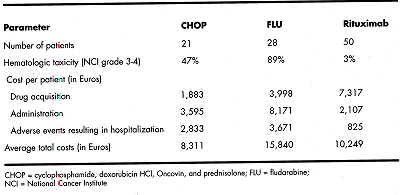Comparative Economic Analysis of the Treatment of Relapsed Low-Grade B-Cell Non-Hodgkin’s Lymphoma (NHL) in France Using CHOP, Fludarabine, or Rituximab
In 1998, a retrospective cost-minimization analysis from the perspective of a British hospital was performed comparing the use of cyclophosphamide, doxorubicin, Oncovin, and prednisolone (CHOP), fludarabine (FLU [Fludara]), and rituximab
In 1998, a retrospective cost-minimization analysis from the perspective of a British hospital was performed comparing the use of cyclophosphamide, doxorubicin, Oncovin, and prednisolone (CHOP), fludarabine (FLU [Fludara]), and rituximab (Rituxan) in the treatment of relapsed low-grade non-Hodgkins lymphoma (NHL; Br J Haematol 106:47-54, 1999). The same comparative analysis was carried out for the French health care system, emphasizing for each regimen the incidence and cost of treatment of adverse events. These regimens are also the most commonly used in France as salvage treatments of relapsed B-cell low-grade NHL.
Retrospective, questionnaire-based data were collected for patients receiving CHOP (N = 21) and FLU (N = 28) in France. Data on the method of administration (inpatient vs outpatient), length of stay, incidence and management of adverse events, and hospitalization related to toxicity were collected. Similar data were collected for rituximab from different sources (guidelines, literature, expert opinion, summary of product characteristics dated June 1999, special license use) and were modeled for a theoretical cohort (N = 50).
The cost of each regimen was calculated from the National Cost Study (French diagnosis-related groups [DRGs], April 1999). The cost of a full course of treatment was calculated from the cost of an individual cycle of therapy on a per-patient basis.
A full course of CHOP or FLU comprised a median of six cycles. CHOP and FLU were administered on an inpatient basis in 62% and 48% of patients, respectively. The median length of stay for those patients was 1 and 5 days, respectively. Rituximab was delivered on an outpatient basis for a full course of treatment of four cycles.
Only hematologic adverse events were assessed using the National Cancer Institute (NCI) grade for each of these salvage regimens. Hematologic adverse events and hospitalization-related toxicity were submitted to statistical testing.

Rituximab was associated with fewer hematologic adverse events than CHOP (P < .001) and FLU (P < .001) and resulted in significantly less hospitalization-related toxicity than CHOP (P = .021) and FLU (P = .048; all tests chi-square). Treatment costs were higher with rituximab compared with CHOP (P = .001) and lower compared with FLU (P < .001; Kruskal-Wallis test).
CONCLUSION: It appears that the method of administration and the low treatment-related toxicity offset the higher drug cost of rituximab. These results confirm the results of the previous study in the United Kingdom.
Click here for Dr. Bruce Chesons commentary on this abstract.